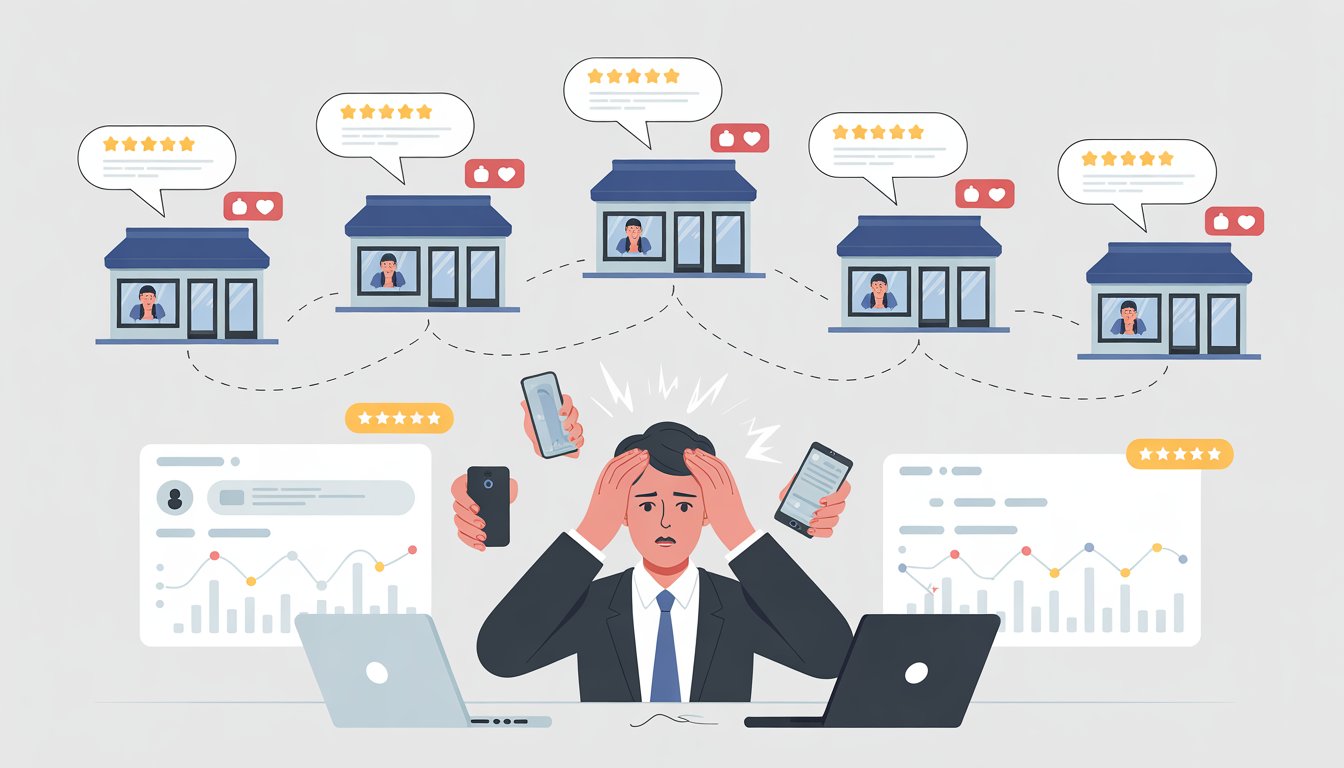Finding factual errors in customer reviews can be frustrating, especially when incorrect information might mislead future customers.
Whether someone got your business hours wrong, confused your location, or misunderstood your services, these mistakes can hurt your reputation if left unchecked.

When you find factual errors in a review, respond politely by thanking the reviewer, gently correcting the specific mistake with accurate information, and providing evidence when possible.
Your response should stay professional and helpful rather than defensive or confrontational.
Most review platforms give you tools to address these situations through public responses or direct communication with reviewers.
You can also report reviews that contain serious factual errors to the platform for review.
Taking quick action helps protect your business while showing you value honest feedback.
Key Takeaways
- Respond to factual errors by politely correcting the mistake with accurate information and supporting evidence.
- Use review platform tools to report serious factual errors or communicate directly with reviewers when possible.
- Prevent future factual errors by providing clear information about your services, hours, and policies upfront.
Understanding Factual Errors in Online Reviews

Factual errors in reviews differ from personal opinions and can seriously harm your business reputation.
These mistakes range from wrong dates and prices to completely false claims about your services.
Defining Factual Errors Versus Opinions
A factual error is a statement that can be proven wrong with clear evidence.
This includes incorrect dates, wrong prices, false claims about services you offer, or events that never happened.
An opinion is someone's personal view or feeling about their experience.
Opinions cannot be proven right or wrong because they reflect individual feelings.
You can correct factual errors with proof.
You cannot argue with opinions, but you can address the concerns behind them.
Common Types of Factual Errors
Wrong business information appears often in reviews.
Customers might list incorrect hours, addresses, phone numbers, or services you don't offer.
Pricing mistakes happen when reviewers state wrong costs or fees.
They might confuse your prices with another business or remember old pricing.
Timeline errors occur when customers get dates or order of events wrong.
They might mix up when they visited or how long something took.
Service mix-ups happen when reviewers describe services you don't provide.
They might confuse you with competitors or misunderstand what you offer.
Payment and policy confusion shows up when customers wrongly describe your return policies, payment methods, or business rules.
Why Accuracy in Online Reviews Matters
Future customers rely on review details to make decisions.
Wrong information can drive away potential clients or create false expectations about your business.
Your reputation suffers when factual errors go uncorrected.
People might believe false claims about your prices, services, or policies without knowing the truth.
Search rankings can drop when reviews contain wrong business information.
Search engines use review content to understand your business, and errors confuse these systems.
Legal protection becomes important when reviews contain false statements that hurt your business.
Correcting factual errors creates a record of the truth.
Evaluating the Impact of Factual Errors

Factual errors in online reviews can create serious problems for your business across multiple areas.
These mistakes affect how customers see your company and can lead to legal issues if not handled properly.
Potential Consequences for Businesses
Factual errors in online reviews can hurt your business operations in several ways.
Wrong information about your products or services confuses potential customers.
Customers may avoid your business based on incorrect details about prices, hours, or locations.
This leads to lost sales and reduced revenue.
Key business impacts include:
- Decreased customer inquiries and bookings
- Lower conversion rates from online searches
- Reduced foot traffic to physical locations
- Damaged relationships with suppliers or partners
Your staff may spend extra time answering questions about false information.
This takes away from other important work tasks.
Search engines may rank your business lower if reviews contain conflicting facts about your company.
This makes it harder for new customers to find you online.
Effects on Consumer Perception
Online reviews with factual errors shape how people view your business before they visit.
Customers often trust review information more than company websites.
Wrong details about product quality or customer service create false expectations.
When reality differs from what reviews describe, customers feel disappointed or confused.
Consumer behavior changes include:
- Choosing competitors based on incorrect comparisons
- Sharing negative opinions with friends and family
- Posting additional negative reviews about their experience
- Questioning the reliability of positive reviews
Social media amplifies these perception problems.
Customers share their confusion about conflicting information across multiple platforms.
Trust becomes harder to rebuild once customers doubt your business credibility.
New customers may research more carefully or avoid your business entirely.
Legal and Reputational Risks
Factual errors in reviews can create legal problems if they contain false statements about your business practices.
Some incorrect information may qualify as defamation under certain circumstances.
Your business reputation suffers when wrong information spreads across review platforms.
Professional relationships with other businesses may become strained.
Serious risks include:
- Regulatory investigations based on false compliance claims
- Customer lawsuits over misrepresented services or policies
- Loss of professional licenses or certifications
- Difficulty attracting quality employees
Insurance companies may question your business practices if reviews contain factual errors about safety or operations.
This could affect your coverage rates.
Banks and investors may view your business as higher risk if online reviews contain conflicting financial information.
Future funding opportunities could become limited.
Best Practices for Responding to Reviews With Factual Errors
When you find reviews with wrong information, you need to stay calm and professional while gently correcting the facts.
Your goal is to set the record straight without making the review writer feel attacked or embarrassed.
Staying Professional and Neutral
Keep your emotions in check when you see factual errors in reviews.
Take time to calm down before writing your response.
Don't use words that sound angry or defensive.
Avoid phrases like "you're wrong" or "that's not true." These make you look unprofessional.
Use neutral language instead.
Start with "Thank you for your feedback" or "We appreciate you sharing your experience." This shows respect for the reviewer.
Keep your tone:
- Respectful
- Calm
- Professional
- Understanding
Write like you're talking to a friend, not fighting an enemy.
Remember that other customers will read your response too.
They judge your business based on how you handle problems.
Don't argue with the review writer.
Focus on sharing correct information in a helpful way.
Providing Supporting Evidence
Back up your corrections with proof when possible.
This helps other readers understand what really happened.
Share specific details that show the correct information.
If a reviewer says your store closes at 5 PM but you actually close at 7 PM, mention your posted hours.
Types of evidence you can use:
- Business hours posted on your website
- Photos of your location or products
- Policy information from your website
- Receipt details (without personal info)
- Security camera timestamps
Don't share private customer information.
Only use facts that are already public or general business information.
Be specific with your evidence.
Instead of saying "that's not our policy," explain what your actual policy is.
This educates both the reviewer and future customers.
Correcting Details Respectfully
Address the factual error directly but gently.
Use phrases like "We'd like to clarify" or "For accuracy, we want to share the correct information."
Pick the most important errors to correct.
You don't need to fix every small detail.
Focus on facts that could mislead future customers.
Example correction phrases:
- "We want to provide accurate information"
- "To help clarify this situation"
- "The correct details are"
- "We'd like to set the record straight"
Explain the correct information clearly.
Use simple words that anyone can understand.
Break complex topics into short, easy sentences.
Thank the reviewer for giving you a chance to share the right information.
This keeps your response positive and helpful rather than confrontational.
Communicating With the Review Writer
Direct communication with the review writer can help fix factual errors quickly.
You can reach out through public or private channels and ask them to correct wrong information in their review.
Reaching Out Privately or Publicly
Private contact works best for most situations.
Look for the review writer's email address or contact form on their website.
Social media direct messages also work well.
Send a polite message that explains the factual error.
Point out the specific mistake without attacking the reviewer.
Include proof like links or documents that show the correct information.
Public responses should only happen when private contact fails.
Reply to the review on the same platform where it was posted.
Keep your tone professional and factual.
Avoid arguing or getting defensive.
Simply state the facts and provide evidence.
Other readers will see your response and can judge for themselves.
Remember that public responses stay visible to everyone.
Make sure your reply helps your reputation instead of hurting it.
Requesting Corrections or Updates
Ask the review writer to fix the error in a clear and direct way.
Explain exactly what needs to change and why it matters.
Provide the correct information in your request.
Include sources or proof that back up your claim.
Make it easy for them to understand the mistake.
Give them a reasonable deadline for the correction.
Most reviewers will fix honest mistakes when you point them out politely.
If they refuse to make changes, document your request and their response.
This record might help if you need to contact the platform later.
Thank them if they do make the correction.
Building a good relationship with reviewers helps prevent future problems.
Using Platform Tools to Address Factual Errors
Most review platforms offer built-in tools to help businesses address factual mistakes in reviews.
These tools let you flag incorrect information and keep your business details up to date.
Flagging or Reporting Reviews
Review platforms provide reporting systems for reviews with factual errors.
You can flag reviews that contain false information about your business hours, location, services, or pricing.
TripAdvisor lets you report reviews through their "Report Concern" feature.
Click the flag icon next to any review to start the process.
You'll need to select the reason for reporting and provide details about the factual error.
Most platforms require specific evidence when you report a review.
Take screenshots of your correct information from your website or official documents.
Write a clear explanation of what's wrong in the review.
Common reasons for flagging reviews include:
- Wrong business hours or dates
- Incorrect pricing information
- False claims about services offered
- Mistaken location details
Response times vary by platform.
Some review sites respond within 24-48 hours.
Others may take up to a week to investigate your report.
Updating Listings and Information
Keep your business information current across all platforms to prevent factual errors.
Outdated listings often lead to confused customers who leave inaccurate reviews.
Update your Google My Business, TripAdvisor, and other platform profiles regularly.
Check these details monthly:
Information TypeExamplesContact DetailsPhone, email, websiteHoursDaily hours, holiday schedulesServicesMenu items, amenities, policiesLocationAddress, parking, directions
Many platforms let you bulk update information.
Use platform management tools to sync changes across multiple sites at once.
This saves time and reduces mistakes.
Set up alerts for when customers edit your business information.
Some platforms allow user-suggested edits that could be wrong.
Review and approve changes before they go live.
Preventing Factual Errors in Future Reviews
The best way to handle factual errors is to stop them before they happen.
You can reduce mistakes by setting clear expectations and making it easy for customers to give accurate feedback.
Encouraging Constructive Feedback
Make feedback channels obvious and accessible.
Put review links in emails, receipts, and on your website.
When customers can easily find the right place to leave reviews, they're more likely to share thoughtful comments.
Create simple guidelines for what makes a helpful review.
Ask customers to include specific details about their experience.
This helps the review writer focus on facts instead of vague complaints.
Timing matters for getting accurate reviews.
Send review requests within 24-48 hours of service completion.
Fresh memories lead to more precise details and fewer mistakes.
Offer multiple ways to give feedback.
Some customers prefer phone calls or emails before writing online reviews.
This gives you a chance to clear up confusion early.
Train your staff to ask for feedback directly.
When employees check in with customers during service, they can spot problems right away.
This prevents small issues from becoming big complaints with wrong information.
Ensuring Clear Communication With Customers
Write clear policies and post them where customers can see them. Use simple language to explain your services, prices, and rules.
When expectations are clear from the start, fewer customers will write confused reviews.
Give customers written confirmations for appointments and orders. Include important details like dates, times, and costs.
This creates a record both of you can refer to later.
Train your team to explain things clearly during interactions. Use specific terms and avoid jargon.
Ask customers if they have questions before they leave.
Follow up after service to make sure customers understand what happened. A quick call or email can prevent misunderstandings that lead to factual errors in online reviews.
Keep detailed records of customer interactions. When you have accurate notes, you can quickly spot and correct any mistakes in reviews.
Frequently Asked Questions
Business owners often face complex situations when reviews contain wrong facts or unfair claims.
These questions address how to handle different review scenarios while maintaining professionalism and protecting your reputation.
What is the best approach to take when responding to a negative review?
Stay calm and respond within seven days. Customers expect quick responses to negative feedback.
Thank the reviewer by name when possible. Address them personally rather than using generic greetings.
Apologize even if you believe the situation wasn't your fault. This shows you care about customer experiences and builds trust.
Take responsibility without making excuses. Acknowledge their experience while maintaining your professional standards.
Provide contact information to move the conversation offline. This prevents further public discussion and shows genuine interest in resolving the issue.
Can a business owner dispute or correct factually inaccurate information in an online review?
You can politely correct factual errors in your public response. Focus on providing accurate information without attacking the reviewer.
State the facts clearly and simply. Avoid lengthy explanations that might seem defensive.
Use phrases like "We'd like to clarify" or "Our records show" when presenting correct information. This sounds professional and factual.
Most review platforms don't remove reviews unless they violate specific policies. Your response becomes the way to share your side of the story.
Document everything related to the transaction. Keep records that support your version of events in case you need them later.
What are some effective strategies for addressing negative comments on social media platforms?
Respond quickly on social media since posts move fast in news feeds. Other customers will see how you handle complaints.
Keep your response brief and professional. Social media users prefer short, direct answers.
Move detailed discussions to private messages when possible. This protects both parties' privacy and prevents arguments in public comments.
Never delete negative comments unless they contain offensive language or false claims about your business. Deleting valid complaints makes you look dishonest.
Use social media responses as a chance to show your customer service values to everyone following your page.
In what way should a business publicly reply to a 1-star review that contains misrepresentations?
Start with gratitude for their feedback, even though the review is inaccurate. This sets a professional tone from the beginning.
Gently correct major factual errors without being confrontational. Present your facts as additional information rather than calling the reviewer wrong.
Avoid going point-by-point through every error. This makes your response too long and defensive.
Focus on your commitment to quality service. Explain briefly how you normally handle the situation they described.
Invite them to contact you directly to discuss their concerns further. This shows other readers that you take complaints seriously.
How can I craft a professional response to a negative Google review that I believe is unfounded?
Thank the reviewer and express regret that their experience didn't meet expectations. This standard opening works even for unfounded complaints.
Share relevant facts without directly contradicting the reviewer. For example, mention your normal procedures or policies that relate to their complaint.
Keep your emotional reaction out of the response. Write your response, wait a few hours, then review it before posting.
Highlight positive aspects of your business that relate to their complaint. If they complain about slow service, mention your typical response times.
End with an invitation to discuss the matter privately. This gives you a chance to resolve things away from public view.
What are key points to consider when replying to a bad review to ensure the response is constructive?
Address the specific issues mentioned in the review. Generic responses make it seem like you didn't read their complaint carefully.
Use a tone that matches your brand personality while staying professional. Your response represents your business to future customers.
Proofread your response before posting. Spelling and grammar mistakes hurt your credibility, especially when defending your business quality.










